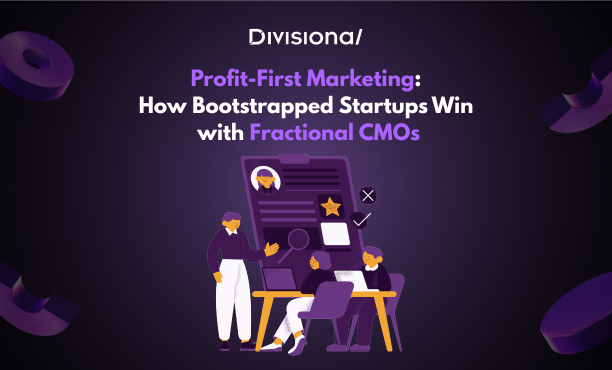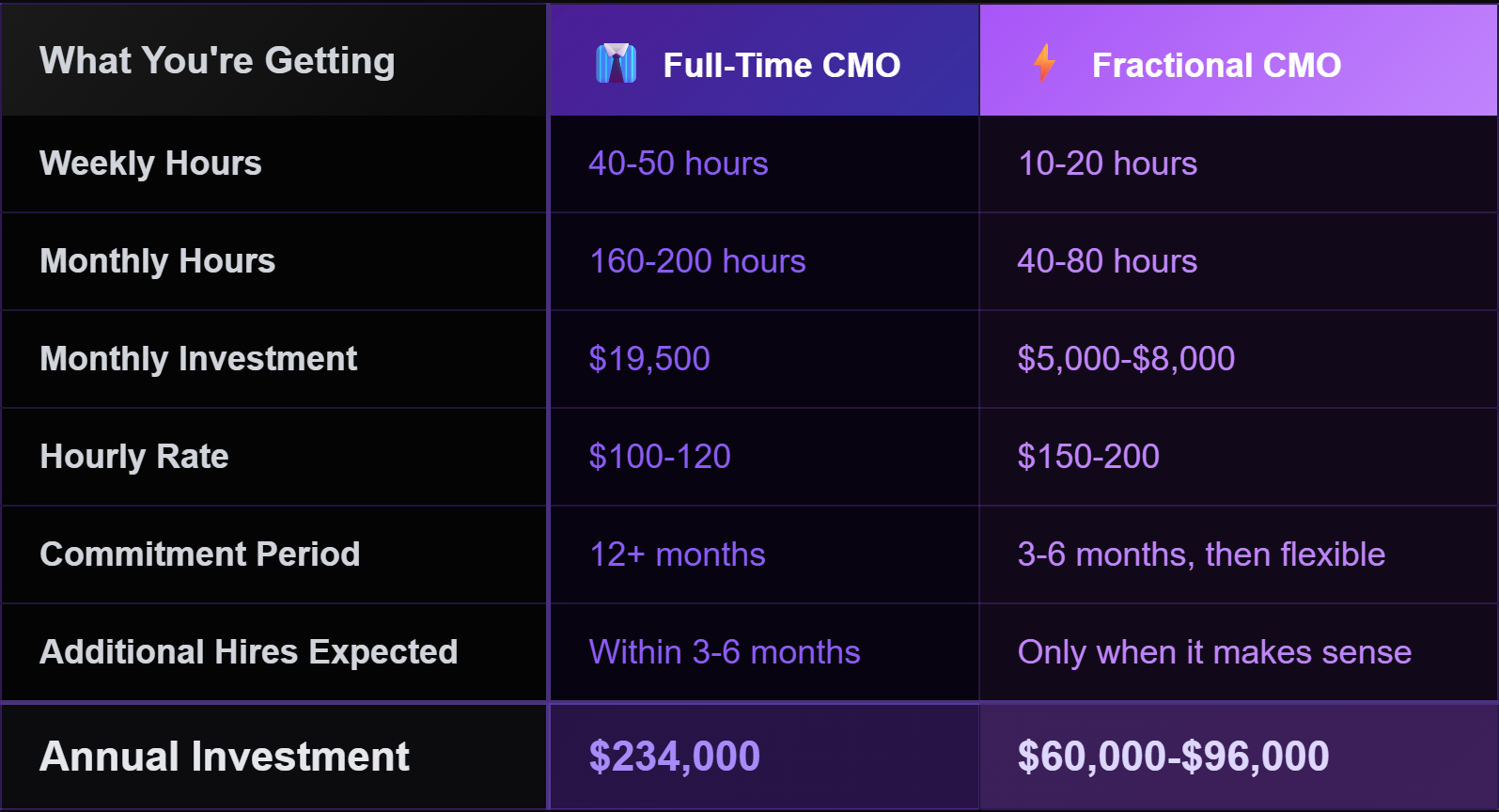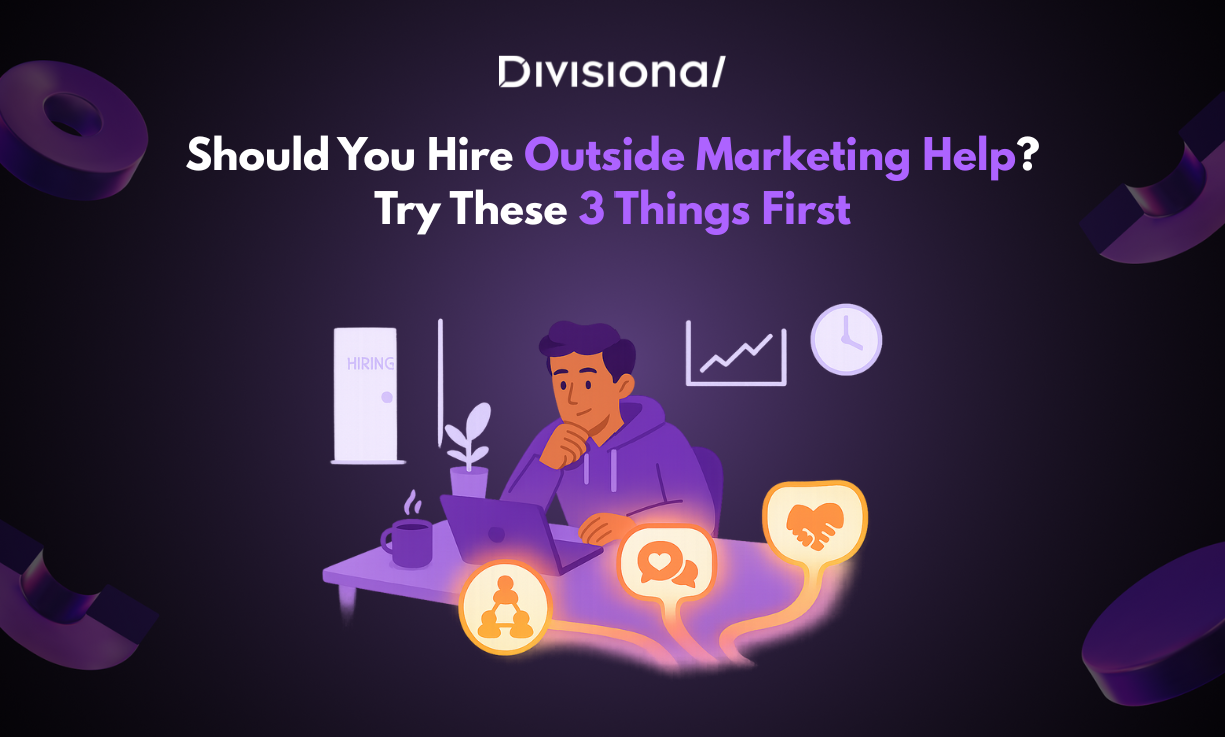
Growth
Jul 28
Profit-First Marketing: How Bootstrapped Startups Win with Fractional CMOs
Most bootstrapped founders get to 7-figures before they even think about hiring a marketing leader. But when they do, a full-time CMO burns cash fast, and the results don't make them feel like it was worth it.
This is a story I've watched dozens of times: you bootstrap your way to serious revenue through pure grit, figuring things out as you go. Then suddenly, you hit a wall. You're not struggling, but those marketing tactics that got you here don't work like they used to.
Sound familiar? Although your early growth efforts are losing steam, dropping $230,000+ on a full-time marketing executive feels like gambling, not investing.
I've seen a better way that works for other founders like you. It's about getting more from your business while keeping your runway safe and your profit margins healthy.
Why You're Looking for Marketing Leadership Now
The Founder's Dilemma
You built something real through hard work, tons of mistakes, and never giving up. Now you're stuck at a crossroads: How do you take marketing to the next level without breaking what already works?
Here's your reality: You can hire offshore talent to reduce the cost of your engine, and you can use AI tools to make the execution easier. But you're missing a leader who can see the big picture and make the tough calls, not just another person who runs ads or writes blog posts.
The Numbers Don't Lie
Before you post that job listing, let's add up what you're actually spending:
- Base salary: $150,000-$180,000
- Benefits and taxes: $30,000-$45,000 (20-25% on top)
- Equity: 0.5-2% (worth $30,000-$150,000+ down the road)
- Tools budget: $1,500-$3,000 every month
- Team budget: More hires within 3-6 months ($8,000-$12,000 monthly)
(We have a table below, wonder if there's a better way to present this info. Graphic with meta data so it still gets captured? Not a big deal, but not as skimmable / it's dense text with the numbers)
Did you actually run these numbers? Most bootstrapped companies face a $230,000-$240,000 commitment per year before they see any results.
Marketing leaders get some of the biggest paychecks outside of tech roles. CMO total pay averages $234,000 even at early-stage companies. That puts serious pressure on founders who've worked hard to stay profitable while growing.
What Else Could You Do With That Money?
That $230,000-$240,000 budget could instead keep your lights on for 12+ more months, fund your entire product roadmap for the year, run targeted campaigns with clear ROI, hire multiple specialists who nail specific channels, or let you invest in customer success to keep more customers.
The real cost isn't just money. It's what you give up. Every dollar you spend too early on marketing leadership takes away from things that already work.
The $230K Mistake
Here's what I saw happen: A bootstrapped SaaS company at $3M in revenue hired a full-time marketing leader for $150K plus benefits and equity. Nine months and over $230K later, they had a pretty new brand, lots of marketing activity, but revenue barely moved.
The real problem wasn't the hire itself. They didn't need a full-time CMO. They needed someone to point their existing team in the right direction, decide what mattered most, and ask tough questions without building their own kingdom.
This isn't just theory. We've seen it happen multiple times with companies like Arist, where their CEO Ryan recognized that at their stage, they needed better execution of a founder-led strategy rather than a completely separate marketing leadership layer. Adding a fractional marketer from Divisional like Season for strategic gut checks proved much more cost-effective when they felt they were maxing out what worked.
What Makes Fractional Marketing Work for Bootstrapped Companies
The Real Cost Comparison
Here's how the numbers actually break down:

Yes, the hourly rate for a fractional CMO costs more, but you pay for focused expertise without all the overhead. Think of it this way: a fractional CMO at 20 hours/week with clear goals versus a full-time CMO who might spend time building their empire instead of solving your actual problems.
That difference of around $160,000 isn't just savings. It's cash you can put to work in other parts of your business while still getting the marketing leadership you need.
From Planning to Results in Weeks, Not Months
A full-time CMO typically spends their first 30-90 days just learning your business before they change anything. A fractional leader can't afford that luxury, which works in your favor.
Here's how it usually goes: Week 1-2, they dig deep and spot quick wins. Week 3-4, they build a strategy your team can actually execute. Month 2, things start moving with your existing people. Month 3, you see real movement on the numbers that matter.
Fractional CMOs excel at creating plans your current team can run with. This is perfect if you already have ideas but need someone to sharpen them and drive them forward.
Hire for Skills, Not Titles
Here's the problem with affordable full-time CMOs: they're usually good at everything but great at nothing. Many come from environments where they ran existing engines rather than breaking through ceilings that hard-working founders are striving for. A CMO at a mid-sized services company that's been around for 20 years operates differently than someone helping a bootstrap founder push past growth barriers.
Fractional leadership flips this dynamic completely. You get senior-level expertise you couldn't afford full-time, they focus on your specific problems (getting customers, positioning, team building), there's no pressure to justify their job by doing more stuff, and they've solved similar problems at other companies like yours.
You're not hiring a title. You're hiring someone to fix specific things that are blocking your growth.
Protecting Your Profit Margins
Here's how profit protection works with fractional help:
- Month 1 - Strategy work ($8-15K investment)
- Month 2-3 - Executing with your current team (margins stay the same)
- Month 4-6 - Scaling what works (spend more only on proven results)
- Month 6+ - Improving systems, less hours required (from 20 hours/week to 10).
This won't necessarily speed things up. Execution will likely be slower compared to a full-time person. But it'll be more focused and cash-smart, protecting the margins you've worked so hard to build.
Three Ways Fractional CMOs Actually Help Bootstrap Companies
Working with bootstrap companies, I see three situations over and over where fractional marketing creates real change. These aren't fairy tales about going from zero to profitable, or seeing 10x growth overnight. These are real scenarios for established bootstrap companies that have been around for 7-10 years, making several million in revenue with solid teams of 10+ people. See if any of these sound familiar:
1) When You're the Marketing Bottleneck
The Problem: You built a $3-10M business through industry knowledge and direct relationships. You hit a ceiling. Despite knowing your stuff inside and out, marketing becomes inconsistent and completely depends on your limited time.
How Fractional Helps: Instead of replacing your valuable insights, Fractional CMOs create systems to scale them. This usually means:
- Writing down your unique approaches that actually convert
- Building processes others can follow to get your results
- Creating measurement systems to prove what's working
What Happens: You cut your marketing involvement by half within months while keeping or speeding up growth. Your business keeps its authentic voice while building systems that don't need you involved every day.
What could you accomplish if marketing wasn't eating up your mental energy?
2) When Your Team Has No Direction
The Problem: You've collected capable specialists across different channels—a content writer, paid media manager, designer, etc.—but you're missing the layer that connects their work. Despite having talent, everyone works separately with different priorities.
How Fractional Helps: Fractional CMOs create connections between existing work through:
- Weekly planning sessions that align all marketing activities
- Cross-team projects that use multiple specialists
- Clear success metrics everyone understands and works toward
- Knowledge-sharing systems that break down information walls
- Being the crucial liaison between the founder and the rest of the team, which is a major unlock that founders want
What Happens: The same team typically delivers 30-50% more impact within three months, without adding headcount. Team satisfaction goes up as work gets direction and visible impact.
3) When You Want to Protect Your Margins
The Problem: You've kept healthy margins and worry that scaling marketing means giving up profitability. Previous growth attempts have been inconsistent and hurt your margins.
How Fractional Helps: Your Fractional CMO brings a careful, staged approach that:
- Focuses on initiatives with proven ROI first
- Sets clear spending limits for all marketing activities
- Creates measurement systems that track profitability, not just growth
- Scales investment only after results are proven
What Happens: Companies typically grow marketing output 2-4x while keeping their strong profit margins. Every marketing dollar spent delivers measurable returns.
What These Examples Show
Looking at these situations, I see the same things working every time:
- Systems over personalities: Creating processes that don't depend on specific people
- Integration over isolation: Connecting marketing to other business functions
- Results over activity: Focusing on impact rather than just doing stuff
- Evolution over revolution: Building on what works rather than starting over
The right fractional approach doesn't bring radical change. It amplifies what you're already good at while systematically fixing what's blocking your growth.
Finding Your Perfect Fractional Fit
Matching Leadership Styles to How You Work
Not all bootstrap companies need the same type of marketing leadership, and it depends on your specific situation and how you lead.
If you're hands-on with marketing and have strong ideas but need someone to refine and execute them, look for a fractional CMO who excels at building processes and enabling teams. If you focus more on operations and stay less involved in marketing details, you need a fractional leader with stronger strategic direction who can operate more independently.
Similarly, a technical product-led organization needs different marketing leadership than a sales-driven business. Which of these sounds most like you?
Your First 90 Days With a Fractional CMO
Setting clear expectations starts before you even hire. During interviews, work with candidates to identify the core problems you're solving. Is it team training, fixing customer acquisition or retention challenges, or sharpening customer messaging?
Once they start, here's how the most productive first 90 days usually go:
Weeks 1-2: Analysis, stakeholder interviews, and opportunity mapping
Weeks 3-4: Strategy development and resource alignment
Weeks 5-8: Initial implementation and process creation
Weeks 9-12: Measurement, iteration, and knowledge transfer
The goal isn't just better numbers—it's better capability within your organization.
Worth mentioning: Before the 90-day clock starts, smart founders are already setting goals and thoroughly checking out potential fractional leaders. This prep work ensures you're not wasting valuable time once things begin.
Building Systems That Last
The real value of a fractional CMO isn't just their direct work. It's the systems they build that keep producing value when they're not there.
This includes decision frameworks that empower your team, documentation that captures what you know, measurement systems that provide clear guidance, training processes that make your existing talent better, and feedback loops that drive continuous improvement.
Great fractional leaders focus on multiple parts of your marketing: internal processes, team development, and channel strategy. They're rarely single-channel focused, even when tackling specific challenges like SEO or content.
Take SEO as an example. An effective fractional CMO won't just work on SEO alone. They'll tackle related areas like internal processes, team member support, and connected channels (organic content, lifecycle experience, etc.). It's a comprehensive improvement rather than a narrow fix.
Signs It's Time to Change Your Marketing Structure
Your relationship with a fractional CMO should change over time. Watch for these signs that it's time to adjust: revenue growth moves faster than marketing capacity, core strategies are solid and mainly need execution, internal team members have grown to take on leadership, marketing ROI consistently beats targets, or company growth requires more embedded leadership.
This evolution might mean reducing fractional hours, moving to a different type of support, or potentially hiring full-time leadership if the numbers now make sense.
Handling Common Worries About Fractional Leadership
"We Need Someone Executing, Not Just Making Plans"
This is a real concern, and the truth is that a fractional CMO alone isn't a good fit if you have no execution power or working channels and systems in place.
You're either hiring them expecting they'll build out an execution team (though not to the same extent a full-time CMO would need), or more likely, you're hiring them to fix existing work, set strategy, and manage your internal team against those goals.
The most effective fractional setups balance strategy (30-40% of time) with hands-on execution guidance (60-70%), compared with 100% execution that you might be expecting. Over time, this often shifts as your team develops, with hours naturally reducing from 20 hours/week to 10 hours/week by months 3-6.
A fractional CMO isn't just someone who comes up with ideas. They manage the execution too. The difference is they build systems that scale over time, which is why you can gradually reduce their involvement as your internal capabilities grow stronger.
"Will They Get Our Business?"
This concern speaks to needing a true sparring partner, not just a marketing executor. The right fractional CMO brings experience with your specific business challenges, so you'll respect their opinion when making important decisions.
Look for industry-relevant experience (though not necessarily direct competitors), familiarity with your business model (SaaS, services, e-commerce), evidence they've solved similar challenges elsewhere (like breaking out of a referral-only engine), and a collaborative approach to getting started (they speak your language).
The getting-started process should include structured knowledge transfer, stakeholder interviews, and deep immersion in your product and customer experience.
Remember that early point about needing a sparring partner? This is where it becomes crucial. As a founder, you don't just need someone who can execute marketing tactics. You need someone whose strategic judgment you trust enough to challenge your thinking when necessary. The best fractional CMOs become trusted advisors whose opinions carry weight because they've been in your specific trenches before.
"What About Growing Our Internal Team?"
A skilled fractional leader can be better at developing your team than a full-time hire who might see strong internal talent as threatening.
The development approach: They create structured growth plans for promising team members while providing mentorship and specific skill development. They delegate strategic responsibilities with appropriate support, build frameworks that help junior marketers make better decisions, and create opportunities for team members who want to step up.
Some of the best success stories involve team members who step up dramatically under fractional guidance, eventually taking on expanded responsibilities. This is especially important for bootstrap companies where junior marketers may have joined with ambitions to grow. A good fractional CMO creates the structure that allows team members who want to contribute to marketing to have that opportunity, with proper guidance and leadership.
"Is This Just a Temporary Fix?"
Fractional leadership isn't a temporary fix. It's a smart way to grow while keeping your cash flow healthy.
For some companies, the fractional relationship evolves but continues for years as the business scales, while for others, it provides a bridge to full-time leadership once the numbers make sense and the foundation is solid.
The key difference with fractional leadership is that this evolution happens intentionally based on results, not because you've already committed to a full-time salary.
Taking the Next Step
Thinking about trying fractional marketing? Here's how to know if you're ready and what to do next.
First, check out our "Readiness Checklist for Startups Hiring a CMO". It'll help you figure out if this makes sense for where you're at.
Then do these three things:
Write down your biggest marketing headaches - What's actually stopping you from growing, and what's working that you want more of?
List what you've got to work with - Who's on your team, what channels are you already using, and what processes exist?
Decide what success looks like in 90 days - How will you know this is working?
The best bootstrap founders I know don't succeed by cutting corners. They succeed by making smart choices that fit how their business actually works.
Want to talk through how this might work for your specific situation? Let's grab a call and figure it out together.

